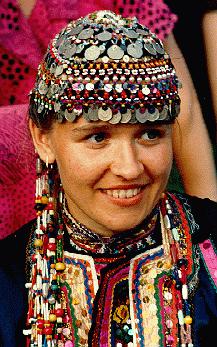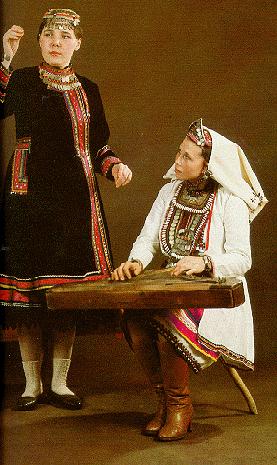

Mari Woman from Orenburg in the southern Ural Mountains
Finno-Ugric People
The Finno-Ugric people are the original inhabitants of the European and Eurasian north that belong to a separate "Uralic Family" linguistic group. The Finno-Ugric substratum is present over a wide area within and outside Russia, from Norway to the Urals and down to the Black Sea.
In these pages, the term "race" is not used to describe groups of people because it is merely a construct and does not exist in reality. There is no race of Finns,
Russians, or even Englishmen. Besides, the term is not useful in most cases
because everyone living today is of more or less mixed genetic content. The idea
of a "master race" or "superior race" has been thoroughly disproved. Racism is a term derived from the concept of "race." But it is really just hatred and violence against anyone different from oneself or of what they consider a lower grade stock, by someone who imagines belonging to some elite or higher group as for example royalty. Race theory presupposes that at one time there existed separate races, which in time started to mix, and there is no proof of that - quite the opposite. According to anthropologists we all came from Africa. Further, the total spectrum of humans, whether traits be based on color or any other criteria, is impossible to separate into categories. What will be the catergories? Who will decide? A person would end up in different groups depending on what criteria was used. Attempts to broaden the concept of race to "white", "black", "yellow", "brown" or whatever is filled with similar problems. What shades are "white" and could you have siblings belonging to different "races?" Therefore categories of "race" really have no place in good science at all, in the opinion of the writer. It is a concept which blurrs science. Besides, the main difference between all people for our purposes is cultural and linguistic, and the rest are subjects for feature character analyses of people. These can be categorized statistically, but cannot be sorted into "races" as such. Mari People Under Attack by Russians 2005 - Sign protest sheet. As the ice retreated about 10,000 years ago, stone-age men, perhaps early
Finns, occupied the rich new lands between Norway and the Urals. They were
followed by other wanderers in the North, many of which were Germanic. According
to Matti Klinge, (University of Helsinki), the dominant "genetic element" in
Finland today is Germanic.
Perhaps Germanic people had also followed game northward since the dawn of
history and were accepted there amongst the Finns. When the waves of disease
swept over Europe, it is possible that the germanic genetic traits (ie. the ones
carrying specific immune factors, such as blood type A), survived because the
immune factors were already there and did not have to be produced by the human
immune response. In this way, beneficial traits were gradually imported along
with technology to the North from Europe.
Newcommers filtered in to Finland over millennia and were absorbed by other arctic, possibly related people. The writer does not believe that the Finnish people "arrived" there from somewhere else, filling a vaccum. They had already been moving East and West for millennia on their ancient water-ways. The choice to settle in any area, including the present day Karelia and Finland was made for various reasons relating to survival in the north. The Finland we are talking about is not the present political boundary area, for their wilderness trips covered a much wider area and involved trade through various middle-men. The term Finn shall refer to Finnic people, covering the area between Norway and the Volga and North to the White Sea. Immigrants to these northern wilderness hunting, trapping and fishing grounds were from many different places, but over time they mixed and created the Finnish people. From this perspective, Finnish, like Saami, is an indigenous language of the north independent of genetics.
The eastern Finnic nations
mixed with wanderers from the south and east and therefore they
differ genetically from the western Finns. This genetic variability was beneficial to the
eastern Finns as well. Biological diversity is what helps species to survive, and this applied to the Finns as well. Naturally, in different geographical areas gene pools differ due to "genetic drift," which is a very well understood phenomenon. The Volga Finnic people are referred to as Finns here even though they differ
significantly in many ways, especially in the language which is mostly
conversationally unintelligible to Baltic Finns.
Chapter 1: The Volga Finns: The Mari People

Mari Kusle, "Kantele" in Finnish - traditional musical instrument.
|
|
|
The Mari People
(by Vassili Nikolajev translated from Finnish by Osmo Joronen)
The Mari people are a middle Volga ancient Finno-Ugric nation.
Based on cultural differences, the Mari are divided into three groups: Mountain, Meadow and Eastern Mari.
Linguistically Meadow and Eastern Maris together form the Eastern Mari dialect and Mountain Mari is called the Western Mari dialect, which includes the dialects of Mari residing in Vetluga River regions. The relative composition of Mari people are: Mountain Mari 10%, Meadow Mari, 60% and Eastern Mari 30%. They have their own literary language, but most use the Eastern Mari literary language (85-90%), namely the native speakers in Mari El Republic's East half, those residing on the North shore of the Volga (Meadow Mari), those in Baškortostan and Tatarstan, Udmurtia, Perm and Sverdlovsk provinces. The Western Mari dialect is spoken by 10-15% of Mari people ie. those on the South bank of the Volga and some Mari in Nishni-Novgorod and Kirov provinces.
Mari Educational System is born
Geography and Statistics
Today Mari El is not a much bigger piece of the Volga shore than Mikkeli province in Finland. Its area is 23 300 km2. Mariland is a part of the Russian Federation. The population in 1993 was 760 000. The breakdown was as follows: Mari 43% and Russians 47%, Tatars 6%, Tšuvash 1,3% etc. Mariland has altogether 50 nationalities.
The majority of television and radio is in the Russian language. Every
day Mari television has 2-3 hours of programs where half is in Mari and the
other half in Russian. Joškar-Ola radio has 18.5 hours of programs which is
split 50-50 between Mari and Russian. Included in the Mari programming is also
some Western Mari dialect programs. The Mountain Mari, in Tsykma (Kosmodemyansk)
have their own radio station.
(Vassili Nikolajev, 1997 - an ethnic Mari) Vasli's Finno-Ugric
Magazine
Uralic and Finno-Ugric Links
Theories of Finno-Ugric language ancient Sumerian and Dravidian affinities:
© 1998 - 2005 Osmo Joronen